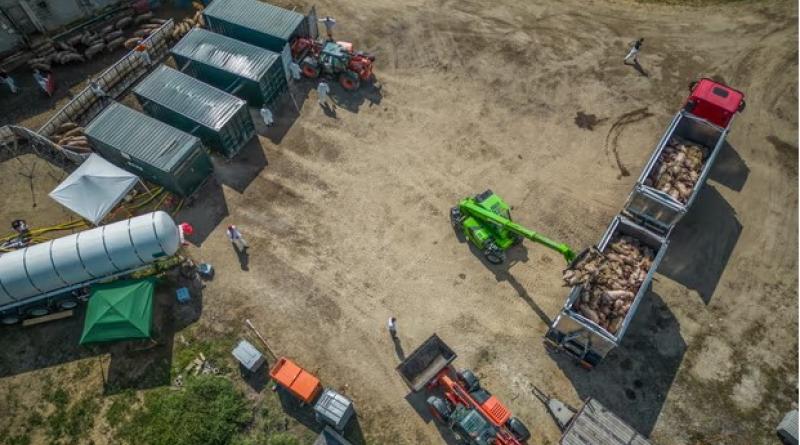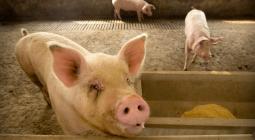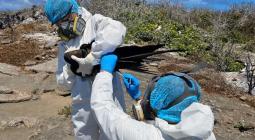Italy culls tens of thousands of pigs to contain African swine fever

Outbreaks in the Lombardy ‘pork belt’ were extinguished, say experts, but wild boar could act as a reservoir
Huge pig culls took place last week in Italy in an attempt to contain the country’s largest outbreak of African swine fever (ASF) virus since the 1960s, which threatened the entire pig-farming sector.
ASF is deadly to pigs and poses a serious threat to the global pig industry but is not a danger to humans, according to the World Organisation for Animal Health (WOAH).
The virus, the organisation said, “is highly resistant in the environment … [and can] survive on clothes, boots, wheels, and other materials”. It added: “It can also survive in various pork products, such as ham, sausages or bacon,” meaning that “human behaviours can play an important role in spreading this pig disease across borders if adequate measures are not taken”.
As of May this year, 24 different variants, or genotypes, of the virus had been identified. WOAH said that mortality rates for pigs that contract the virus can be up to 100%.
Almost 34,000 pigs were culled in Italy last week after a cluster of outbreaks in Lombardy, a region known as Italy’s pork belt and one of Europe’s main pig-producing areas.
“The cluster of outbreaks [in Lombardy] was the largest in Italy caused by the ASF virus genotype II,” said Francesco Feliziani, who leads Italy’s national reference lab for swine fever.
He said the Lombardy outbreak had been “quickly extinguished” but “posed a major threat to the entire sector as the region is the largest producer of pigs in our country”.
Because there is no vaccine for ASF, Feliziani said culls to contain the disease were compulsory. The underlying problem, he said, “remains the presence of the virus in the wild boar populations”, which provide a reservoir for the virus.
“In Europe, the threat [of ASF] is very strong; the pressure of the virus is high and it seems inevitable that the disease will involve other domestic herds,” he said.
ASF was disrupting pig breeding around the world, Feliziani said, but he warned that non-intensive, traditional livestock farming models, which might not have sufficient levels of biosecurity, were particularly at risk and could disappear altogether.
“This would have strong economic repercussions on many social strata and would also affect the biodiversity of rural areas where intensive livestock farming is not possible, and which survive thanks to the typicality of products reared according to traditional methods,” he said.
To control ASF outbreaks in China, producers are building multistorey pig farms that are deemed to have higher standards of disease control compared with backyard herds.
Video footage of the Lombardy culls, filmed by the NGO We Animals Media in collaboration with NGO Essere Animali, showed “an overview of the procedure, including an infected farm that had been adapted to work as a mobile slaughterhouse, operating nonstop for over a week”, a spokesperson said in an email.
“Workers received pigs from other infected farms and herded them into temporary gas chambers set up inside containers, where the animals were killed,” they said.
While ASF posed a “significant risk to wild boar diversity” in Asia, this was not the case in Italy, where there were large numbers of native animals, the spokesperson added.
The Italian culls, although large, were not the biggest so far in Europe, said Vincent ter Beek, the editor of Pig Progress, who has been tracking the ASF outbreak around the world.
“ASF also occurred in Romania a few years back,” he said. “In comparison … [the Italian culls] are relatively small numbers. And let’s not talk about numbers in Russia or China. I’m not trying to downplay anything, the amount is terrible for both producers and pigs, but it’s not the biggest in the EU.”
Humans and wild boar were the biggest risks for spreading the disease, he said. “Humans can make the virus appear 500km down the road in a wild boar population, as happened in Sweden a few weeks back, and wild boar then spread it among themselves.”
Given that wild boar are not tracked and traced, Ter Beek said the disease could spread in any direction but, he added, the spreading of the disease by boar “doesn’t usually happen fast, it goes bit by bit”.
Ter Beek said that Germany appeared to be doing well at controlling ASF and its efforts could provide a blueprint for dealing with the virus in wild boar, “even though terrains and boar population densities are different everywhere”.
The result of the virus spreading among boar would probably be “a wild boar population that is vastly lower, temporarily,” said Ter Beek. However, he added, an abundance of food and relatively mild winters meant numbers would rebound fairly quickly, with the ASF virus coming back in waves from time to time, making it hard to eradicate from a country.
Experts from the Federation of Veterinarians of Europe said: “Since 2017, more than 2.3 million pigs were lost due to ASF in Europe. Although it is harmless to humans, it can be deadly for pigs and has serious socioeconomic consequences for affected countries. As no vaccine exists yet in Europe, early detection, prevention and reporting are key to curbing this deadly disease. We all should take this seriously.”
Photograph: Selene Magnolia/Essere Animali/We Animals Media - Pig culling at a farm in Lombardy, northern Italy, last week.






